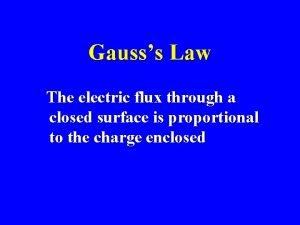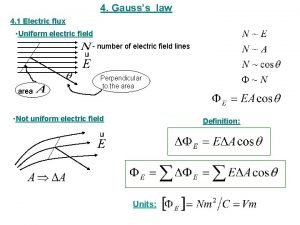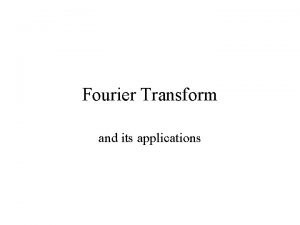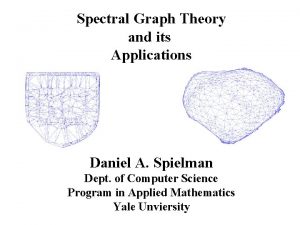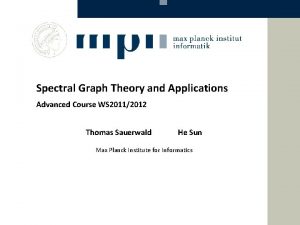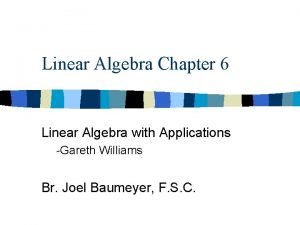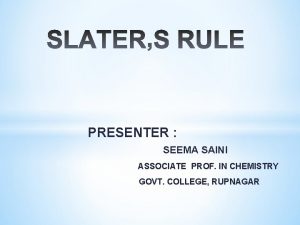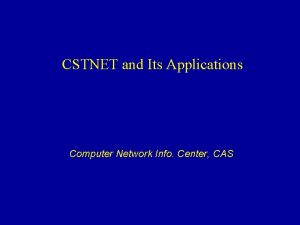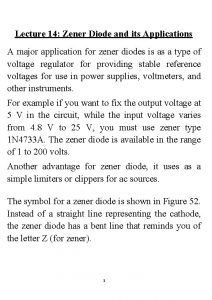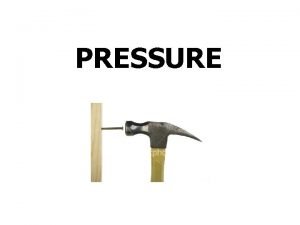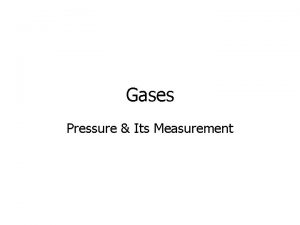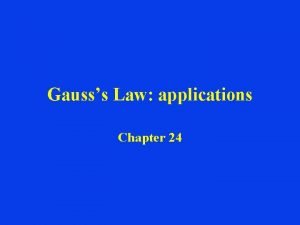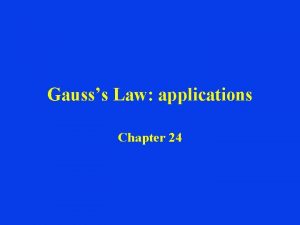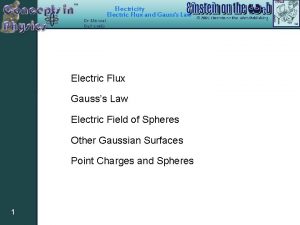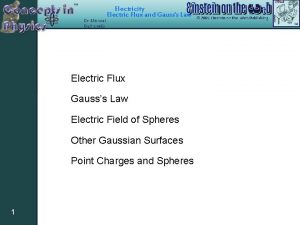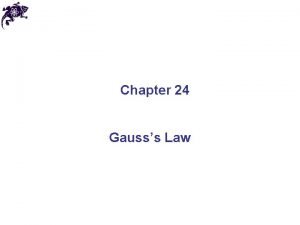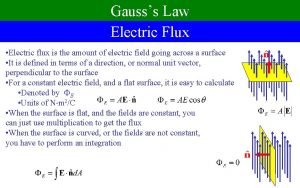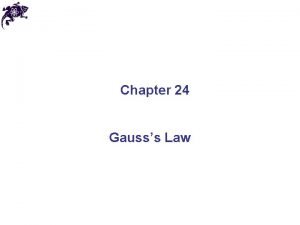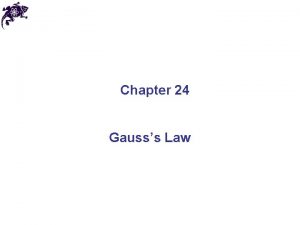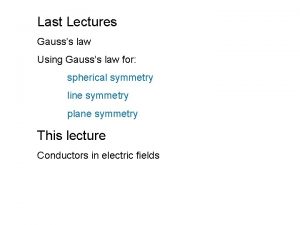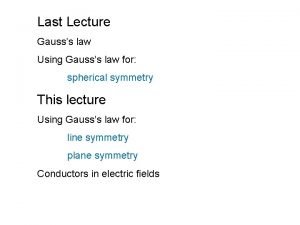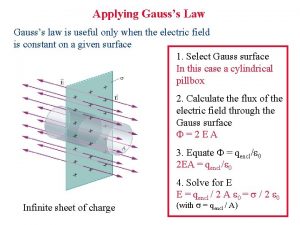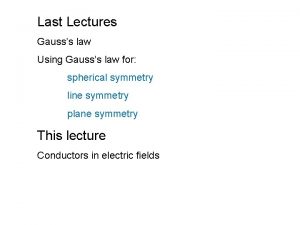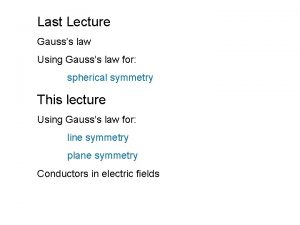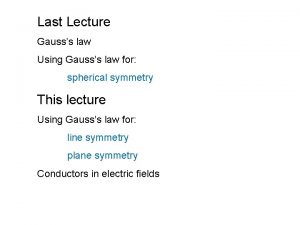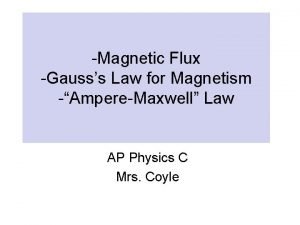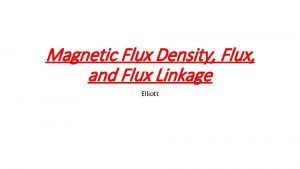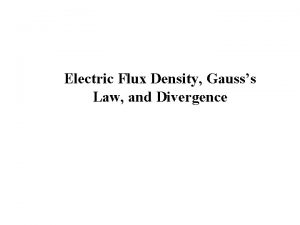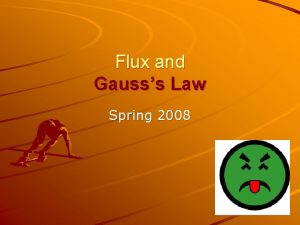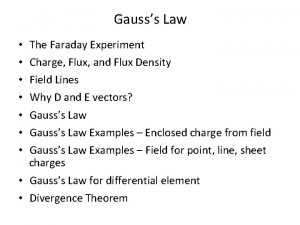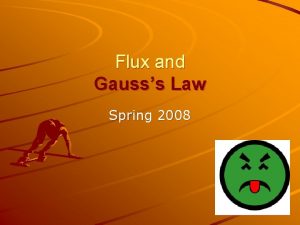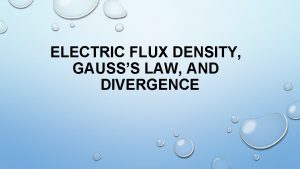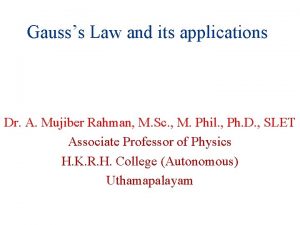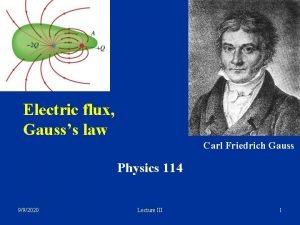Chapter2 Gausss Law and its Applications Flux of
























- Slides: 24

Chapter-2 (Gauss's Law and its Applications) Flux of the electric field: Flux is the property of any vector field and is usually denoted by the symbol φ. It refers to a hypothetical surface in the field which may be closed or open. For an electric field the flux is φE is measured by the number of lines of force that cut through such a surface. For closed surfaces the flux φE is considered positive if the lines of force point outward everywhere and negative if they point inward. The concept of electric flux is useful in association with Gauss' law. The electric flux through a planar area is defined as the electric field times the component of the area perpendicular to the field as shown in Fig-1 (a). If the area is not planar, then the evaluation of the flux generally requires an area integral since the angle will be continually changing as shown in Fig-1 (b). 1

Chapter-2 (Gauss's Law and its Applications) Fig-1 (a) Fig-1 (b) 2

Chapter-2 (Gauss's Law and its Applications) Gauss’s law: Gauss's law was suggested by Kark Fredrich Gauss (1777 -1855) who was German scientist and mathematecian. Gauss's law is basically the relation between the charge distributions producing the electrostatic field to the behavior of electrostatic field in space. Gauss's law is based on the fact that flux through any closed surface is a measure of total amount of charge inside that surface and any charge outside that surface would not contribute anything to the total flux. The total electric flux out of a closed surface is equal to the charge enclosed divided by the permittivity. 3

Chapter-2 (Gauss's Law and its Applications) The electric flux through an area is defined as the electric field multiplied by the area of the surface projected in a plane perpendicular to the field. Gauss's Law is a general law applying to any closed surface. It is an important tool since it permits the assessment of the amount of enclosed charge by mapping the field on a surface outside the charge distribution. For geometries of sufficient symmetry, it simplifies the calculation of the electric field. 4

Chapter-2 (Gauss's Law and its Applications) Gauss' Law, Integral Form: The area integral of the electric field over any closed surface is equal to the net charge enclosed in the surface divided by the permittivity of space. Gauss' law is a form of one of Maxwell's equations, the four fundamental equations for electricity and magnetism. Gauss' law permits the evaluation of the electric field in many practical situations by forming a symmetric Gaussian surface surrounding a charge distribution and evaluating the electric flux through that surface. 5

Chapter-2 (Gauss's Law and its Applications) Applications of Gauss' Law: 1. Deduction of Coulomb’s law 2. Electric field due to a charged solid sphere 3. Field due to a spherically symmetric charge distribution (volume distribution of charge) 4. Field due to a line of charge 5. Field due to a uniformly charged plane (sheet of charge) 6. Field due to infinite charged conducting plate 7. Field due to two parallel charged plates. 6

Chapter-2 (Gauss's Law and its Applications) (A) Deduction of Coulumb's Law Coulumb's law can be derived from Gauss's law. We consider electric field of a single isolated positive charge of magnitude q as shown Fig-4. Field of a positive charge is in radially outward direction everywhere and magnitude of electric field intensity is same for all points at a distance r from the charge. We can assume Gaussian surface to be a sphere of radius r enclosing the charge q. From Gauss's law 7

Chapter-2 (Gauss's Law and its Applications) 8

Chapter-2 (Gauss's Law and its Applications) 9

Chapter-2 (Gauss's Law and its Applications) (B) Electric field due to line charge We consider a long thin uniformly charged wire and we have to find the electric field intensity due to the wire at any point at perpendicular distance from the wire. If the wire is very long and we are at point far away from both its ends then field lines outside the wire are radial and would lie on a plane perpendicular to the wire. 10

Chapter-2 (Gauss's Law and its Applications) Electric field intensity have same magnitude at all points which are at same distance from the line charge. We can assume Gaussian surface to be a right circular cylinder of radius r and length l with its ends perpendicular to the wire as shown below in Fig-5. Let λ is the charge per unit length on the wire. The direction of E is perpendicular to the wire and components of E normal to end faces of cylinder makes no contribution to electric flux. Thus from Gauss's law 11

Chapter-2 (Gauss's Law and its Applications) 12

Chapter-2 (Gauss's Law and its Applications) 13

Chapter-2 (Gauss's Law and its Applications) From Gauss’ law, Thus electric field intensity of a long positively charged wire does not depend on length of the wire but on the radial distance r of points from the wire. 14

Chapter-2 (Gauss's Law and its Applications) (C) Electric field due to charged solid sphere We'll now apply Gauss's law to find the field outside uniformly charged solid sphere of radius R and total charge q. In this case Gaussian surface would be a sphere of radius r>R concentric with the charged solid sphere shown below in the figure. 15

Chapter-2 (Gauss's Law and its Applications) From Gauss’ law, where q is the charge enclosed. Charge is distributed uniformly over the surface of the sphere. Symmetry allows us to extract E out of the integral sign as magnitude of electric field intensity is same for all points at distance r>R. Since electric field points radially outwards we have 16

Chapter-2 (Gauss's Law and its Applications) Thus, we see that magnitude of field outside the sphere is exactly the same as it would have been as if all the charge were concentrated at its center. 17

Chapter-2 (Gauss's Law and its Applications) (D) Electric field due to an infinite plane sheet of charge We consider a thin infinite plane sheet of charge having surface charge density σ(charge per unit area). We have to find the electric field intensity due to this sheet at a point which is distance r away from the sheet. We can draw a rectangular Gaussian pillbox extending equal distance above and below the plane as shown in Fig-7. 18

Chapter-2 (Gauss's Law and its Applications) By symmetry we find that E on either side of sheet must be perpendicular to the plane of the sheet, having same magnitude at all points equidistant from the sheet. No field lines crosses the side walls of the Gaussian pillbox i. e. , component of E normal to walls of pillbox is zero. We now apply Gauss's law to this surface In this case charge enclosed is q=σA where A is the area of end face of Gaussian pillbox. E points in the direction away from the plane i. e. , E points upwards for points above the plane and downwards for points below the plane. Thus for top and bottom surfaces, 19

Chapter-2 (Gauss's Law and its Applications) Here one important thing to note is that magnitude of electric field at any point is independent of the sheet and does not decrease inversely with the square of the distance. Thus electric field due to an infinite plane sheet of charge does not falls of at all. 20

Chapter-2 (Gauss's Law and its Applications) Example-1: The magnitude of the average electric field normally present in the Earth’s atmosphere just above the surface of the Earth is 150 N/C, directed downward. What is the total net surface charge carried by the Earth? Assume the Earth to be a conductor. Solution: We know that line of forces terminate on negative charges so that the Earth’s electric field points downward. Hence the average surface charge density σ must be negative. Thus from the relation, E = σ/ε 0 or, σ = ε 0 E = (8. 85 × 10 -12) (-150) = -1. 33 × 10 -9 C/m 2. Now, the Earth’s total charge is given by, q = σ × 4πR 2 21 = -1. 33 × 10 -9 × 4 × (6. 37 × 106)2 = -6. 8 × 105 C.

Chapter-2 (Gauss's Law and its Applications) Example-2: A plastic rod whose length is 220 cm and radius is 3. 6 mm, carries a negative charge of magnitude 3. 8 × 10 -7 C, spread uniformly over its surface. What is the electric field near the midpoint of the rod, at a point on its surface? Solution: Although the rod is not infinitely long, for a point on its surface and near its midpoint, it may be considered to be effectively infinitely long. The linear charge density for the rod is, λ = q/L= -3. 8 × 10 -7 / 2. 2 = -1. 73 × 10 -7 C/m. Now, we have E = λ/2πε 0 r = -1. 73 × 10 -7 /(2π × 8. 85 × 10 -12 22 × 0. 0036) = -8. 6 × 105 N/C.

Chapter-2 (Gauss's Law and its Applications) Example-3: Two parallel plates of area 20 cm 2 each are separated by a distance of 10 mm. If one plate carries a charge of +2 × 10 -9 C and the other carries a charge of -2 × 10 -9 C, calculate the electric field in the space between them. Solution: We know, E = σ/ ε 0 = Q/A ε 0 = 2 × 10 -9 /(20 × 10 -4 × 8. 85 × 10 -12 ) = 1. 13 × 105 N/C. 23

Thank you all 24
 Conclusion of gauss law
Conclusion of gauss law Flux
Flux Hysteresis loop magnetism
Hysteresis loop magnetism Magnetic field strength formula
Magnetic field strength formula Hittorf
Hittorf Newton's first law and second law and third law
Newton's first law and second law and third law Newton's first law and second law and third law
Newton's first law and second law and third law Cro diagram
Cro diagram The fourier transform and its applications
The fourier transform and its applications Daniel spielman spectral graph theory
Daniel spielman spectral graph theory Spectral graph theory and its applications
Spectral graph theory and its applications Diagonalizable matrix
Diagonalizable matrix The resistance r experienced by a partially submerged body
The resistance r experienced by a partially submerged body Fast random walk with restart and its applications
Fast random walk with restart and its applications Screening constant of fluorine
Screening constant of fluorine Nhpce
Nhpce Server client architecture
Server client architecture Boyles law
Boyles law Constant in avogadro's law
Constant in avogadro's law Zener diode and its application
Zener diode and its application Emigree poem analysis
Emigree poem analysis Its halloween its halloween the moon is full and bright
Its halloween its halloween the moon is full and bright Other practical applications of boyle's law
Other practical applications of boyle's law Applications of boyle's law
Applications of boyle's law Real life example of boyle's law
Real life example of boyle's law
